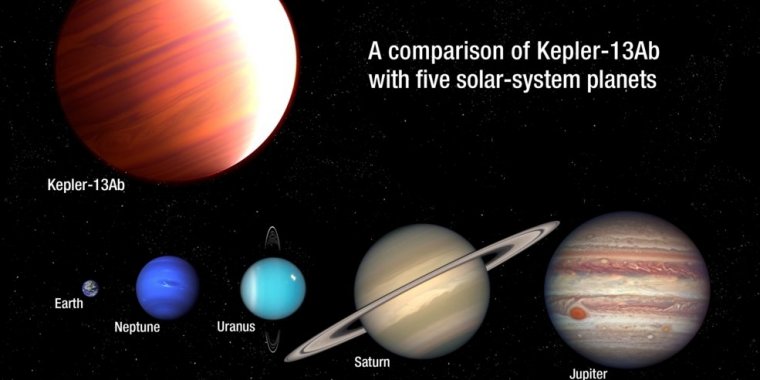| News / Space News |
Hubble Observes Exoplanet that Snows Sunscreen
NASA's Hubble Space Telescope has found a blistering hot planet outside our solar system where it "snows" sunscreen. The problem is the sunscreen (titanium oxide) precipitation only happens on the planet's permanent nighttime side. Any possible visitors to the exoplanet, called Kepler-13Ab, would need to bottle up some of that sunscreen, because they won't find it on the sizzling hot, daytime side, which always faces its host star.

Artist’s impression of the gas giant planet Kepler-13Ab as compared in size to several of our solar system planets. ![]()
Hubble astronomers suggest that powerful winds carry the titanium oxide gas around to the colder nighttime side, where it condenses into crystalline flakes, forms clouds, and precipitates as snow. Kepler-13Ab's strong surface gravity — six times greater than Jupiter's — pulls the titanium oxide snow out of the upper atmosphere and traps it in the lower atmosphere.
Astronomers using Hubble didn't look for titanium oxide specifically. Instead, they observed that the giant planet's atmosphere is cooler at higher altitudes, which is contrary to what was expected.
This finding led the researchers to conclude that a light-absorbing gaseous form of titanium oxide, commonly found in this class of star-hugging, gas giant planet known as a "hot Jupiter," has been removed from the dayside's atmosphere.
The Hubble observations represent the first time astronomers have detected this precipitation process, called a "cold trap," on an exoplanet.
Without the titanium oxide gas to absorb incoming starlight on the daytime side, the atmospheric temperature grows colder with increasing altitude. Normally, titanium oxide in the atmospheres of hot Jupiters absorbs light and reradiates it as heat, making the atmosphere grow warmer at higher altitudes.
Beatty's team selected Kepler-13Ab because it is one of the hottest of the known exoplanets, with a dayside temperature of nearly 5,000 degrees Fahrenheit. Past observations of other hot Jupiters have revealed that the upper atmospheres increase in temperature. Even at their much colder temperatures, most of our solar system's gas giants also exhibit this phenomenon.
Kepler-13Ab is so close to its parent star that it is tidally locked. One side of the planet always faces the star; the other side is in permanent darkness. (Similarly, our moon is tidally locked to Earth; only one hemisphere is permanently visible from Earth.)
The Kepler-13 system resides 1,730 light-years from Earth. (NASA)
YOU MAY ALSO LIKE




